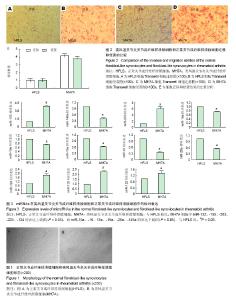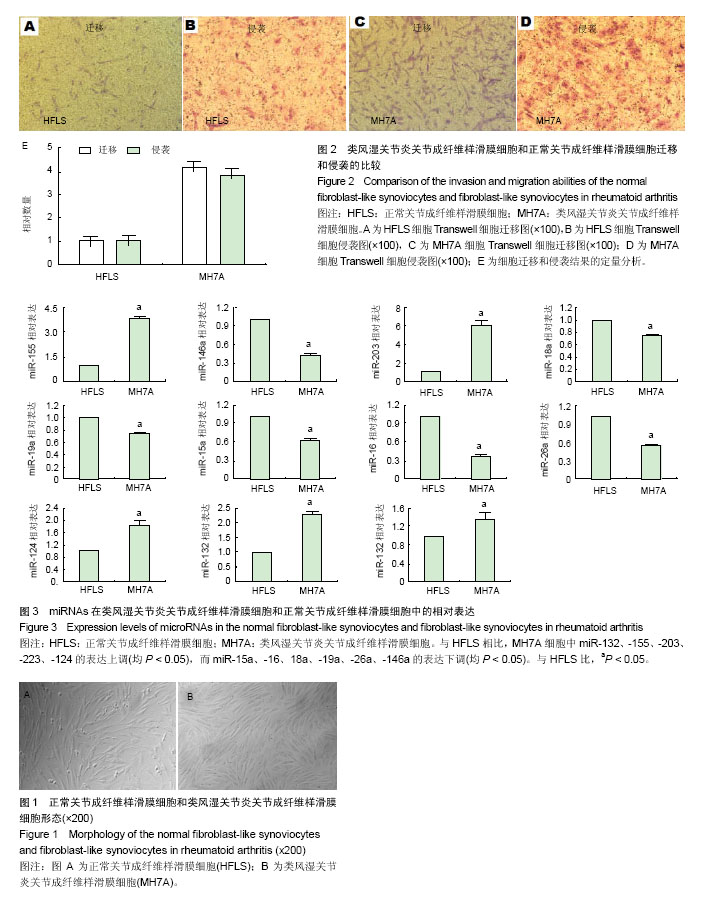| [1] Calin GA, Dumitru CD, Shimizu M, et al. Frequent deletions and down-regulation of microRNA genes miR15 and miR16 at 13q14 in chronic lymphocytic leukemia. Proc Natl Acad Sci USA.2002;99(24): 15524-15529.[2] Calin GA, Ferracin M, Cimmino A, et al. A microRNA signature associated with prognosis and progression in chronic lymphocytic leukemia. N Engl J Med.2005; 353(17): 1793-1801.[3] Michael MZ, O’Connor SM, Young GP, et al. Reduced accumulation of specific microRNAs in colorectal neoplasia. Mol Cancer Res.2003;1(12): 882-891.[4] Pfeffer S,Zavolan M,Grasser FA,et al.Identification of virus-encoded microRNAs. Science.2003;304:734-736.[5] 汤自征,张育,李国青.类风湿关节炎滑膜细胞迁移机制的研究进展[J].中华风湿病学杂志,2013,17(11): 780-783.[6] Li GQ, Zhang Y, Liu D, et al. Celastrol inhibits interleukin-17A-stimulated rheumatoid fibroblast-like synoviocyte migration and invasion through suppression of NF-κB-mediated matrix metalloproteinase-9 expression. IntImmunopharmacol. 2012;14(4):422-431.[7] Li GQ, Zhang Y, Liu D, et al.Interleukin-17A promotes rheumatoid arthritis synoviocytes migration andinvasion under hypoxia by increasing MMP2 and MMP9 expression throughNF-κ B/HIF-1αpathway.Mol Immunol.2013;53(3): 227-236.[8] Stanczyk J, Pedrioli DM, Brentano F, et al. Altered expression of microRNA in synovial fibroblasts and synovial tissue in rheumatoid arthritis. Arthritis Rheum.2008;58(4): 1001-1009.[9] Filková M, Jüngel A, Gay RE, et al.MicroRNAs in rheumatoid arthritis. Potential role in diagnosis and therapy. Biodrugs. 2012;26(3):131-141.[10] Michelle T,Matthias B,Renate EG,et al.Tumor Necrosis Factor–Induced MicroRNA-18a Activates Rheumatoid Arthritis Synovial Fibroblasts Through a Feedback Loop in NF- B Signaling. Arthritis&Rheumatis.2013; 65(4): 916-927.[11] Lucas P, Ghada A, Guillaume S, et al. TLR2 Expression is regulated by microRNA miR-19 in rheumatoid fibroblast-like synoviocytes. J Immunol.2012;188:454-461.[12] Tomoyuki N, Shigeru M, Atsuko O,et al.Expression of microRNA-146 in rheumatoid arthritis synovial tissue. Arthritis Rheum.2008;58(5): 1284-1292.[13] Cimmino A, Calin GA, Fabbri M, et al. miR-15 and miR-16 induce apoptosis by targeting BCL2. Proc Natl Acad Sci USA. 2005;102(39): 13944-13949.[14] Nakamachi Y, Kawano S, Takenokuchi M, et al. MicroRNA-132a is a key regulator of proliferation and monocyte chemoattractant protein 1 secretion in fibroblast-like synoviocytes from patients with rheumatoid arthritis.Arthritis Rheum.2009;60(5): 1294-1304.[15] Koch AE,Kunkel SL,Harlow LA,et al.Enhanced production of monocyte chemoattractant protein 1 in rheumatoid arthritis.J Clin Invest.1992;90(3): 772-779.[16] Koch AE, Harlow LA, Haines GK,et al.Vascular endothelial growth factor: a cytokine modulating endothelial function in rheumatoid arthritis. J Immunol.1994; 152(8): 4149-4156.[17] Akhavani MA, Madden L, Buysschaert I, et al. Hypoxia upregulates angiogenesis and synovial cell migration in rheumatoid arthritis. Arthritis Res Ther.2009; 11(3): R64.[18] Hayatoshi S, Tomoyuki N, Nobuo A, et al. Overexpression of microRNA-223 in rheumatoid arthritis synovium controls osteoclast differentiation. Mod Rheumatol. 2013; 23(4): 674-685. |

